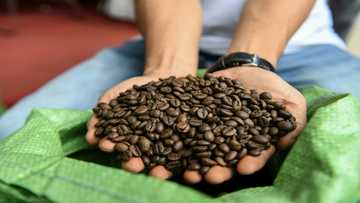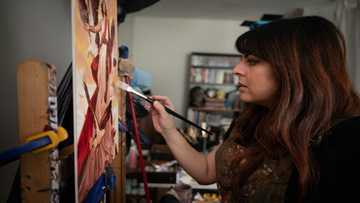China's 'art factory' painters turn from fakes to originals

Source: AFP
PAY ATTENTION: Enjoy reading our stories? Join YEN.com.gh's Telegram channel for more!
Painters in a Chinese village once known for churning out replicas of Western masterpieces are now making original art worth thousands of dollars, selling their own works in a booming domestic art market.
Home to more than 8,000 artists, southern China's Dafen has been producing near-perfect copies of timeless masterpieces for years.
In its heyday, three out of five oil paintings sold worldwide were made in the village, and for years village painters sold their copies to buyers across Europe, the Middle East and the United States.

Source: AFP
Exports began to dip after the 2008 global financial crisis, and all but dried up when China slammed shut its borders in 2020 because of the coronavirus pandemic.
PAY ATTENTION: Сheck out news that is picked exactly for YOU ➡️ click on “Recommended for you” and enjoy!
A few artists gave up and closed their studios. But others saw in the obstacles an opportunity to establish themselves as painters in their own right by catering to China's art market -- the second-biggest in the world, with sales jumping by 35 percent in 2021.
Self-taught artist Zhao Xiaoyong used to sell replicas of Vincent van Gogh's work for about 1,500 yuan ($220) each, while his original pieces fetch up to 50,000 yuan, he said.

Source: AFP
When Zhao moved to Dafen from central China in 1997, his family shared a tiny two-bedroom apartment with five other tenants.
"Those days, there was an assembly line-style system, with each artist painting a small section of a larger piece, like an eye or a nose, before passing the piece to another painter to draw a limb or a shirt sleeve," he told AFP.
After years of cranking out mock masterpieces, Zhao eventually saved enough money to visit the Van Gogh Museum in Amsterdam and the Saint-Paul Asylum in southern France, where the artist famously painted "The Starry Night".
"I felt I could finally enter into his world instead of just copying his brush strokes," Zhao said.

Source: AFP
"I realised I had to come out of Van Gogh's shadow and give life to my thoughts."
Now he chronicles how the Dafen oil painting village has changed, using Van Gogh's style: one canvas shows Zhao in a crowded workshop holding one of the Dutch painter's self-portraits, while fellow artists nap on their desks.
Tourist boost
Since China's dismantling of its zero-Covid policy in late 2022, the streets of Dafen are once again bustling with visitors, crouched in front of easels, slapping paint on canvases.
As well as immersing themselves in the artistic culture with painting lessons, many of the tourists come to buy pieces from the villagers, but their hunt for a good deal is another factor behind the fading market in handmade fakes.

Source: AFP
In one alleyway, workers brush paint onto printed canvases of Duccio's "Madonna and Child".
These are sold for a knock-down price as low as 50 yuan per piece, while a hand-painted copy costs up to 1,500 yuan.
"We paint a few strokes over the printed image to make it look like an authentic oil painting," said one artist, who declined to be named.
"Buyers think the printed background is painted using watercolours."
'Chinese aesthetic'

Source: AFP
Another Dafen-based artist on a mission to move on from painting imitations is Wu Feimin, who has carved out a niche selling Buddhist-themed art.
"I used to copy Picasso's work, and now I have my distinct style," Wu said, painting a giant face of the Buddha with a palette knife.
"It takes weeks, sometimes months, to complete one painting," the artist said as he was getting ready for exhibitions in the village and the rich industrial hub of Guangzhou.
"It's risky, but the margins are better."
Other artists told AFP that they went back to school during the pandemic to learn how to draw mountains and weeping-willow trees seen in traditional Chinese landscape paintings.
"Wealthy Chinese buyers want art that reflects a Chinese aesthetic," said Yu Sheng, a fine-art teacher who used the opportunity to retrain in the classical style.
While he continues to make ends meet by exporting replicas of Western works, he also creates his own pieces, determined to crack the more lucrative domestic market and become a portrait painter for the wealthy.
And he is confident in his abilities over those of artists from well-known schools.
"Our technique is better because we paint every day, but we don't have contacts with art dealers in big cities," he said.
"Our survival depends on whether our work is recognised by China's art buyers -- we must learn to bend like bamboo."
New feature: Сheck out news that is picked for YOU ➡️ click on “Recommended for you” and enjoy!
Source: AFP





